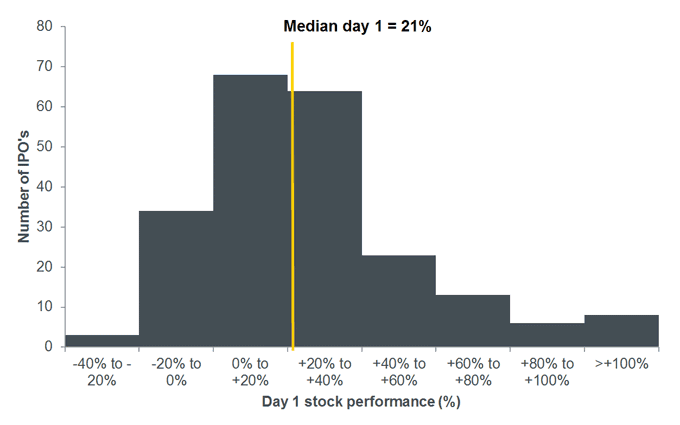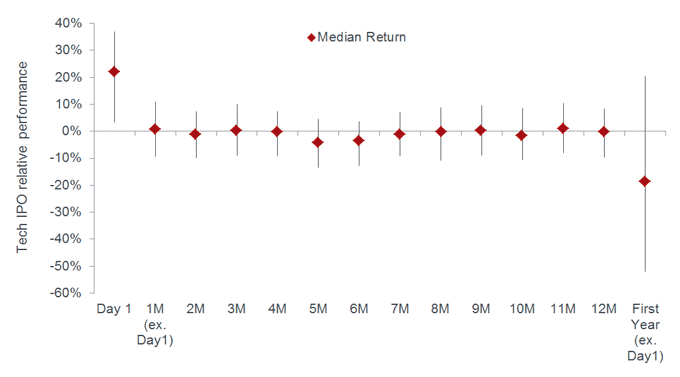
Janus Henderson: How do tech IPOs perform in their first year?
Aneet Chachra, portfolio manager within the Alternatives team, takes a quantitative look at US tech initial public offerings (IPOs) and how they have historically performed post-launch.
09.04.2019 | 15:00 Uhr
Lyft, the ride-sharing transportation network company, went public
to much fanfare, and news reports indicate that many more tech companies
could follow in 2019 including Uber, Pinterest, Airbnb, Slack, and
Palantir. These companies are challenging to analyse because generally
they are growing quickly but are also incurring losses, which makes
forecasting their business and share price performance incredibly
difficult.
A simpler starting point is base
rate analysis – how do technology IPO’s perform on average, and what
have been their observed characteristics? This forms the reference class
and the historical range of outcomes make up the “outside view”. Using
base rates as the initial estimate has been popularised in recent years
by Philip Tetlock (“Superforecasting”) and Michael Mauboussin (“The
Success Equation”).
Let’s build a reference class
of all US-listed tech IPOs launched between 2010-2018 with at least 12
months of trading history post-IPO. There are 220 companies that meet
this criteria.
Notably these deals have historically done very well out of the gate. Tech IPO’s have risen on day 1 about 80% of the time, with a median pop of +21% (Figure 1). For example, Lyft’s +9% opening day gain was about a 32nd percentile outcome applying this base rate approach, so broadly in-line with prior tech IPOs.
Figure 1: US-listed technology IPO day 1 performance

Source: Bloomberg, Janus Henderson, data from January 2010 to March 2018
To
analyse further, for each subsequent month we calculate the median and
the range of observed returns for this set of tech IPOs. In order to
isolate IPO-specific performance, all of the return figures below are
relative to the overall tech sector (calculated as long each IPO / short
S&P Technology index for every month). This controls for the strong
performance of tech over the last decade and appropriately compares
IPOs launched at different times.
Figure 2
shows median day 1, by month, and first-year relative returns for these
220 tech IPOs along with 25th and 75th percentile outcome ranges (the
vertical lines). This provides a visual sense of the distribution of
returns in addition to the median.
Figure 2: Tech IPOs first year as a public company (median and 25th/75th percentile outcomes)

Source: Bloomberg, Janus Henderson, data from January 2010 to March 2019Note: Calculated relative to S&P technology sector index, rebalanced monthly, excludes transaction costs
There are two key things to note looking at the reference class above. The
first is the period of underperformance in the middle of the first year
(see months 5 and 6). This likely corresponds to anticipated and actual
increase in share supply and selling pressure around the lock-up
expiration date (180 days post-IPO). Generally employees and VC backers
must wait for the IPO lock-up period to end before they can sell their
shares in the market and convert paper wealth into liquidity. Given that
pre-IPO holders are often quite concentrated and need to diversify,
they can be price-insensitive and cause significant impact due to their
selling flows.
The second is that the average
first year return (excluding the day 1 pop) for a tech IPO is negative
with a median -19% underperformance relative to the broader tech sector.
To be clear, the range of observed tech IPO outcomes has been extremely
wide ranging from a near wipe-out to a quadrupling within a year. The
variability of returns for a tech IPO is roughly three times greater
than the broader market.
Overall, the average US tech IPO has risen on its first trading day, but its relative return though the rest of its first year has been negative, with the bulk of the underperformance coming 4-7 months after the firm goes public. This is the “outside view” without doing any analysis of the particular company. Buying at the IPO deal price or before has generally paid off, but buying post-debut is taking the “inside view” that your forecast is more accurate than what prior tech IPO experience would initially suggest.




Diesen Beitrag teilen: